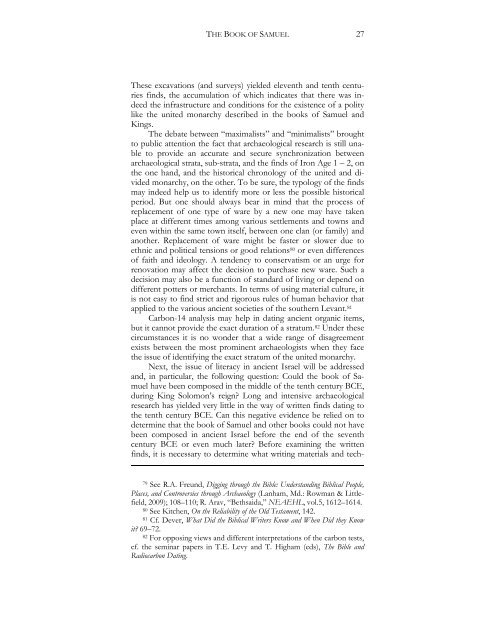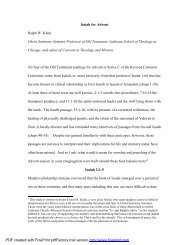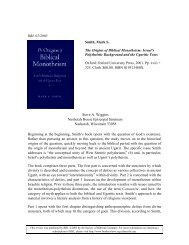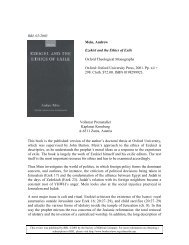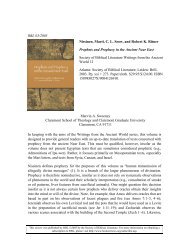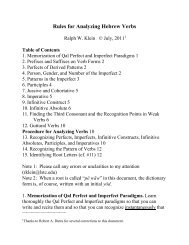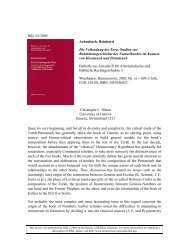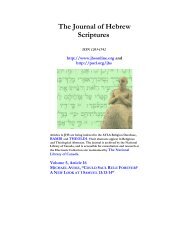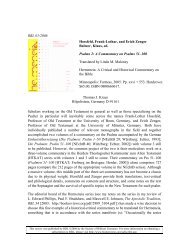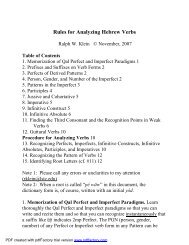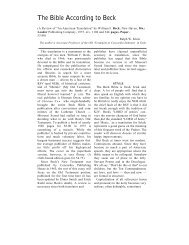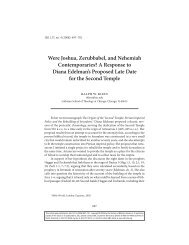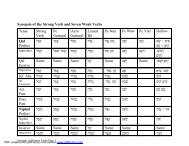The Book of Samuel: Its Composition, Structure and Significance as ...
The Book of Samuel: Its Composition, Structure and Significance as ...
The Book of Samuel: Its Composition, Structure and Significance as ...
Create successful ePaper yourself
Turn your PDF publications into a flip-book with our unique Google optimized e-Paper software.
THE BOOK OF SAMUEL<br />
<strong>The</strong>se excavations (<strong>and</strong> surveys) yielded eleventh <strong>and</strong> tenth centuries<br />
finds, the accumulation <strong>of</strong> which indicates that there w<strong>as</strong> indeed<br />
the infr<strong>as</strong>tructure <strong>and</strong> conditions for the existence <strong>of</strong> a polity<br />
like the united monarchy described in the books <strong>of</strong> <strong>Samuel</strong> <strong>and</strong><br />
Kings.<br />
<strong>The</strong> debate between “maximalists” <strong>and</strong> “minimalists” brought<br />
to public attention the fact that archaeological research is still unable<br />
to provide an accurate <strong>and</strong> secure synchronization between<br />
archaeological strata, sub-strata, <strong>and</strong> the finds <strong>of</strong> Iron Age 1 – 2, on<br />
the one h<strong>and</strong>, <strong>and</strong> the historical chronology <strong>of</strong> the united <strong>and</strong> divided<br />
monarchy, on the other. To be sure, the typology <strong>of</strong> the finds<br />
may indeed help us to identify more or less the possible historical<br />
period. But one should always bear in mind that the process <strong>of</strong><br />
replacement <strong>of</strong> one type <strong>of</strong> ware by a new one may have taken<br />
place at different times among various settlements <strong>and</strong> towns <strong>and</strong><br />
even within the same town itself, between one clan (or family) <strong>and</strong><br />
another. Replacement <strong>of</strong> ware might be f<strong>as</strong>ter or slower due to<br />
ethnic <strong>and</strong> political tensions or good relations 80 or even differences<br />
<strong>of</strong> faith <strong>and</strong> ideology. A tendency to conservatism or an urge for<br />
renovation may affect the decision to purch<strong>as</strong>e new ware. Such a<br />
decision may also be a function <strong>of</strong> st<strong>and</strong>ard <strong>of</strong> living or depend on<br />
different potters or merchants. In terms <strong>of</strong> using material culture, it<br />
is not e<strong>as</strong>y to find strict <strong>and</strong> rigorous rules <strong>of</strong> human behavior that<br />
applied to the various ancient societies <strong>of</strong> the southern Levant. 81<br />
Carbon-14 analysis may help in dating ancient organic items,<br />
but it cannot provide the exact duration <strong>of</strong> a stratum. 82 Under these<br />
circumstances it is no wonder that a wide range <strong>of</strong> disagreement<br />
exists between the most prominent archaeologists when they face<br />
the issue <strong>of</strong> identifying the exact stratum <strong>of</strong> the united monarchy.<br />
Next, the issue <strong>of</strong> literacy in ancient Israel will be addressed<br />
<strong>and</strong>, in particular, the following question: Could the book <strong>of</strong> <strong>Samuel</strong><br />
have been composed in the middle <strong>of</strong> the tenth century BCE,<br />
during King Solomon’s reign? Long <strong>and</strong> intensive archaeological<br />
research h<strong>as</strong> yielded very little in the way <strong>of</strong> written finds dating to<br />
the tenth century BCE. Can this negative evidence be relied on to<br />
determine that the book <strong>of</strong> <strong>Samuel</strong> <strong>and</strong> other books could not have<br />
been composed in ancient Israel before the end <strong>of</strong> the seventh<br />
century BCE or even much later? Before examining the written<br />
finds, it is necessary to determine what writing materials <strong>and</strong> tech-<br />
79 See R.A. Freund, Digging through the Bible: Underst<strong>and</strong>ing Biblical People,<br />
Places, <strong>and</strong> Controversies through Archaeology (Lanham, Md.: Rowman & Littlefield,<br />
2009); 108–110; R. Arav, “Bethsaida,” NEAEHL, vol.5, 1612–1614.<br />
80 See Kitchen, On the Reliability <strong>of</strong> the Old Testament, 142.<br />
81 Cf. Dever, What Did the Biblical Writers Know <strong>and</strong> When Did they Know<br />
it? 69–72.<br />
82 For opposing views <strong>and</strong> different interpretations <strong>of</strong> the carbon tests,<br />
cf. the seminar papers in T.E. Levy <strong>and</strong> T. Higham (eds), <strong>The</strong> Bible <strong>and</strong><br />
Radiocarbon Dating.<br />
27


